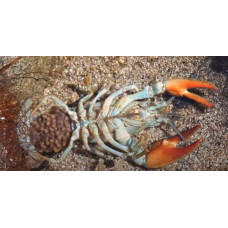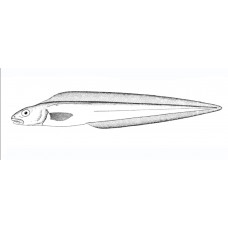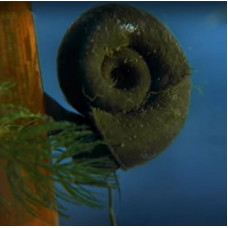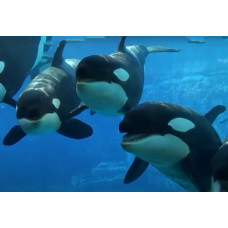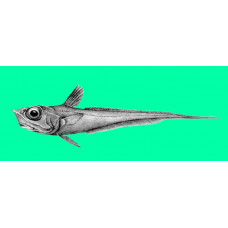Fauna of the Bellingshausen Sea
Geographical position of the Bellingshausen Sea
A marginal sea of the Pacific Ocean on the coast of West Antarctica between the Antarctic Peninsula in the east and Thurston Island in the west. It is bounded in the north by a line from Cape Flying Fish (Thurston island) to the north coast of Peter I Island and the northern tip of Adelaide Island. From the west and south, the sea is bounded by the weakly rugged glacial coast of Antarctica near Elsuerth Land. From the east - by a strongly indented coast with numerous bays. The largest islands are Petra I and Alexander I Land. The sea area is 487 thousand km2, volume 614 thousand km3, average depth 1261 m, maximum depth 4115 m. The Bellingshausen Sea is shallowly cut into the continent and completely open to the north, which causes free water exchange with the adjacent areas of the Pacific Ocean.
Relief of the Bellingshausen Sea
The shelf has depths up to 400-500 m, it is strongly dissected, especially at shallow depths as one approaches the coast, in the central part it is more flat, in the north one can trace a rather extensive closed basin with depths slightly greater than 500 m. The continental slope is rather steep, flat or slightly convex in the upper part and represents a boulder surface. The continental slope is rather steep, flat or slightly convex in the upper part, at depths of more than 2500 m it is a boulder surface with sharp and very irregular edges. At the transition from the slope to the bed, at a depth of about 3200 m, the same boulders are observed as on the slope. The bed occupies a relatively small part of the seafloor. At greater depths, the bottom relief is smoother and the depth increases steadily towards the north.
Climatic conditions of the Bellingshausen Sea
The Bellingshausen Sea is located entirely south of the Arctic Circle, in the Antarctic climate zone, where air from the Antarctic continent prevails throughout the year. The atmospheric pressure is lowered throughout the year and the zonal transport of air masses prevails, influenced by active cyclonic activity. In the winter season, the winds blow from the west, east and northeast directions with a speed of up to 7 m/s, storms are quite frequent from June to August; the air over the sea is strongly cooling, the temperature decreases from north to south from -12 °C near Peter the Great Island to -20 °C near the coast, the minimum values reach -30 °C in the north and -42 °C in the south.
The waters of the Bellingshausen Sea
In winter, the sea is completely covered with ice, the water temperature at the surface is close to freezing point (from -1.7 to -1.9 °C). In summer, the surface water temperature is almost everywhere -1.5 °C, only at the northernmost boundary of the sea it is 1.0 °C or slightly lower. Surface salinity varies slightly, increasing from north to south in winter. In summer, short-term ice melting occurs in the northern parts of the sea, and a tongue of reduced salinity (32.25-33.00‰) can be traced, generally extending from east to west along approximately 68-70° S parallels, which is probably related to the location of the melting ice edge. The density of the water in the Bellingshausen Sea is slightly lower than in the surrounding waters due to its lower salinity. In winter, the surface density is slightly higher than in summer.
Inhabitants of the Bellingshausen Sea
The dominance of polar winds and the predominance of ice cover create unfavorable conditions for flora and fauna. The flora of this sea is represented by phytoplankton and blue-green algae, which can survive under any conditions. The fauna is more diverse. The Bellingshausen Sea is the home of two species of whales, the toothed whale and the baleen whale (humpback whale, sei whale, fin whale). The largest blue whale is also found here. They hunt zooplankton, mainly Antarctic krill, and at depth they can eat echinoderms and sponges. Orca and sperm whales are the main threats to wildlife here. These species live in packs and hunt. In summer, mammals such as seals (crabeater, Weddell, southern elephant, southern fur, leopard) and walruses appear on the shores of the islands. Birds also live there: petrels, skuas, the most famous polar bird - the penguin, of which there are several species. They feed mainly on crustaceans, fish and mollusks. Bellingshausenia olasoi is the only fish species endemic to the Bellingshausen Sea. A little studied fish species, Gosztonyia antarctica, belonging to the family Zoarcidae, was found in the waters of this sea. But the most important representatives of the local ichthyofauna are Antarctic silverfish, Whitson's grenadier, Whitefin plunderfish, Antarctic starry skate, Blue antimora, Chionobathyscus dewitti, Patagonian toothfish, Antarctic toothfish.
Antarctic silverfish
Latin namePleuragramma antarcticaOther nameAntarctic herringIdentificationThe body of the Antarctic ..
Antarctic starry skate
Latin nameAmblyraja georgianaOther nameAmblyraja georgianaIdentificationThe body is relatively thick..
Antarctic toothfish
Latin nameDissostichus mawsoniOther namesAntarctic codIdentificationFirst dorsal fin with 7-9 barb r..
Bellingshausenia olasoi
Latin nameBellingshausenia olasoiIdentificationBellingshausenia olasoi has a slender body with an el..
Blue antimora
Latin nameAntimora rostrataOther nameFlat-nose codling, blue hake, long-finned cod or violet cod.Ide..
Chionobathyscus dewitti
Latin nameChionobathyscus dewittiOther nameГлубинная белокровкаIdentificationChionobathyscus dewitti..
Crustaceans
Crustacea is a class of invertebrates of the Arthropoda type. It includes animals with body length f..
Echinodermata
Echinodermata are an independent and very peculiar type of the animal world. According to the plan o..
Gosztonyia antarctica
Latin nameGosztonyia antarcticaIdentificationGosztonyia antarctica have an elongated anguilliform bo..
Krill
Krill is a commercial name for small marine crustaceans that serve as food for whales, fish, seabird..
Mollusca
A type of secondary invertebrate. Probably originated in the Precambrian; several classes of mollusc..
Orca
Latin nameOrcinus orcaOther namesKiller whaleIdentificationThe Latin orca is thought to derive from ..
Patagonian toothfish
Latin nameDissostichus eleginoidesOther nameChilean sea bass, mero, and icefish.IdentificationThe Pa..
Whitefin plunderfish
Latin namePogonophryne albipinnaOther namePogonophryne albipinnaIdentificationPogonophryne - Greek, ..
Whitson's grenadier
Latin nameMacrourus whitsoniOther nameMacrourus whitsoniIdentificationThe eyes of the Whitson's gren..








